Art World
The World Should Know 94-Year-Old Artist Susan Weil
A show at JDJ Gallery in Tribeca traces the singular artist's career across seven decades.
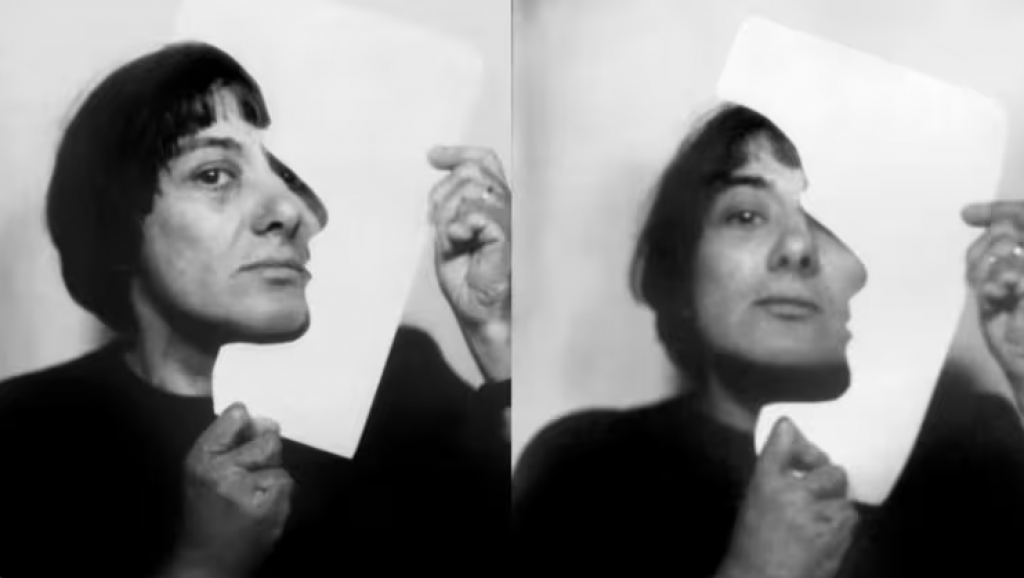
A show at JDJ Gallery in Tribeca traces the singular artist's career across seven decades.

Katie White

Ninety-four-year-old artist Susan Weil has been working in the heart of the contemporary art world for over 70 years—though you might not know her name.
Her quiet profile is all the more surprising the more one learns about this ever-imaginative artist. “I was working when women were pretty much ignored,” said Weil in an interview by email. “It was joyful to see the push for women to speak up and be part of the art world publicly.”
And push Weil did. Born in New York in 1930, she decided to devote her life to art while still a teenager. Inspired by Aaron Kurzen, her high school art teacher, she spent a summer in Paris studying at the Academie Julien. There she met Robert Rauschenberg, with whom she shared her plans to attend the famed Black Mountain College in the fall. She enrolled in Black Mountain in the late 1940s, studying under Josef Albers. Rauschenberg joined her there; the two would begin an artist collaboration and later marry (their brief marriage, from 1950 to 1952, produced a son, Christopher).
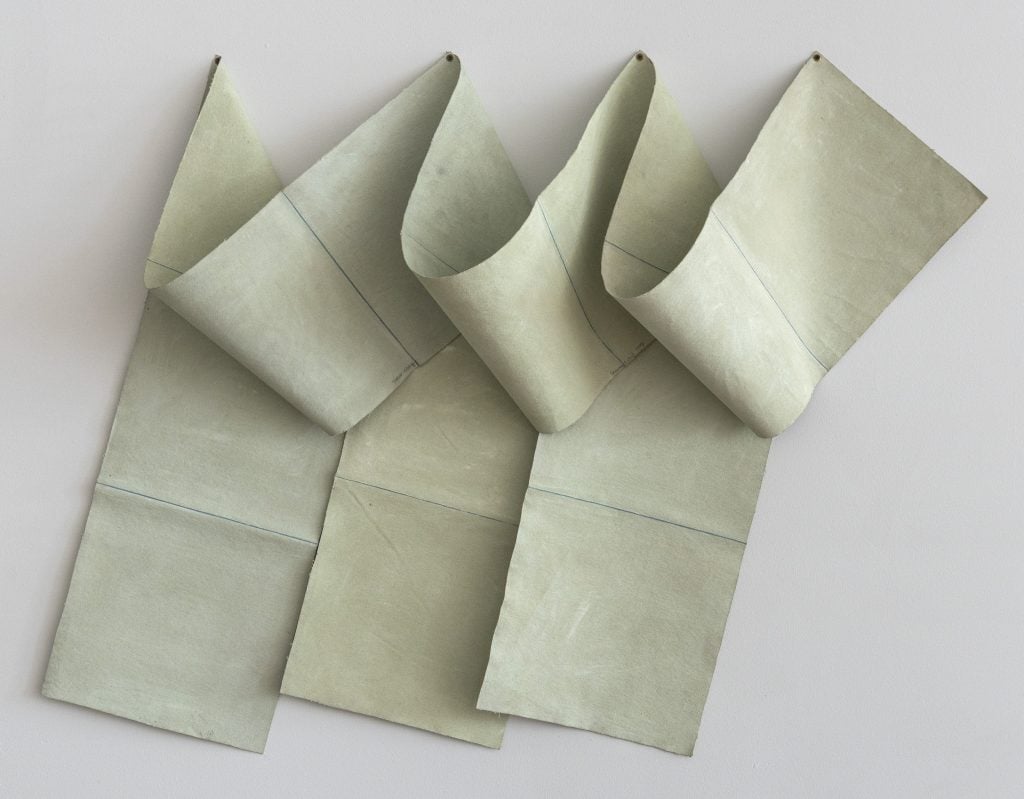
Susan Weil, Three Graces (1986). Photograph by Cary Whittier. Courtesy of JDJ Gallery.
A 1951 issue of Life captures Weil and Rauschenberg smiling side by side creating large-scale body imprints on blueprint paper; Weil, the great-granddaughter of the Chicago architect Dankmar Adler, had introduced Rauschenberg to the medium. “That was a fun working situation,” said Weil of the collaboration.
In the 73 years since that Life magazine photoshoot, Weil has continued to feed her voracious imagination through a multifaceted and experimental practice. “I just loved working and working things out,” Weil said of her creative endurance.
A glimpse of this prolific career is on view right now in the exhibition “Susan Weil” at JDJ in Tribeca. The show offers a refreshing introduction to this overlooked voice through a nimble curation of Weil’s works made between 1968 and 2023 (the show runs through August 2, 2024).

Susan Weil, Aswim (2018). Photograph by Cary Whittier. Courtesy of JDJ Gallery.
The exhibition is JDJ’s third presentation of Weil’s work but this is the most encompassing to date, and grapples with the long curve of her career and interests. While Weil’s works are included in the collections of the Metropolitan Museum of Art, New York; the Museum of Modern Art, New York; and the Moderna Museet, Stockholm, she has not received the critical consideration of many of her peers. Her gallery representation has been sporadic, with her work seeing success in Scandinavia in the 1970s. Sundaram Tagore Gallery, in addition to JDJ, has championed her work in recent years, and momentum around the artist seems to be building. Her work is currently included in “When You See Me: Visibility in Contemporary Art/History” at the Dallas Museum of Art.
The exhibition at JDJ presents Weil’s practice as heady in its scope—collage, spray-painted paper works, folded canvas paintings, art books with poems, and cut-outs all make appearances—while surprisingly unified thematically, centering around motifs of the moon, poetry and literature, movement, and time. “I feel like in exhibitions when you put works from different eras… they’re very comfortable together because you have certain impactful visions that are comfortable even if they’re years apart,” Weil said of the show.
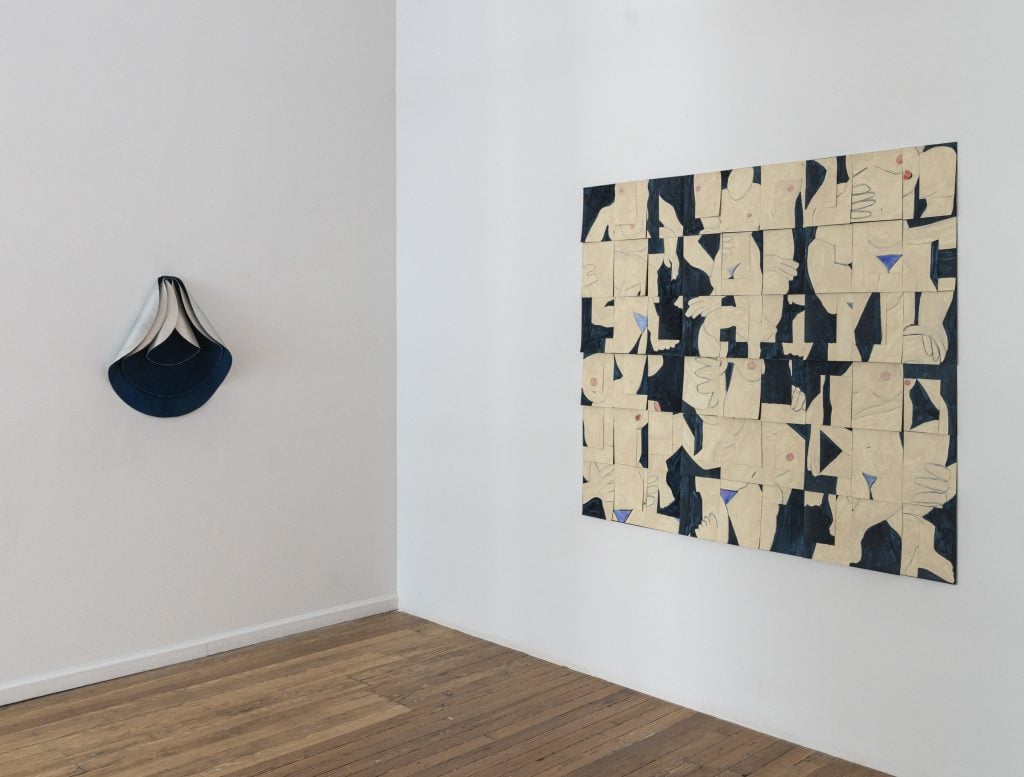
Installation view “Susan Weil” 2024. Photograph by Cary Whittier. Courtesy of JDJ Gallery.
Celestial and physical bodies often appear in motion, fragmenting and reforming. The earliest work in the show, Walking Figure, 1968, presents the silhouette of a man in stride, spray-painted in a rainbow of hues on Plexiglas; the work is a precursor to her “Configurations” series from the 1990s and early 2000s. Weil painted nude female figures on paper, cut them up, and collaged these abstracted bodies into new constellations. A large untitled 1998 work from “Constellation” is on view; with its fragmented and reorganized forms, the collage feels like Weil’s response to Marcel Duchamp’s Nude Descending a Staircase No. 2 (1912), a novel depiction of movement.
The moon is another favorite of Weil’s—an ancient symbol of femininity, the changing seasons, and the cyclical nature of time that she engages with a tender familiarity. “The moon is our planet. And we’re relatives in a bigger universe and it’s very moving,” she explained of her fascination.
Lunar motifs appear across decades’ of Weil’s work, giving her experimental, multimedia works an anchoring classical reference point. In her work, Moon (Half Moon) (1990), layered circles of painted and cut canvas, allude to the moon while echoing, in its folded forms, the robes found in Renaissance paintings. Meanwhile, her painting Shhh! from 2023, with its overlapping concentric circles calls to mind the lunar phases, and with its only gently iridescent surfaces, underscores the subtleties of perception and the limitations of what is seen and unseen.
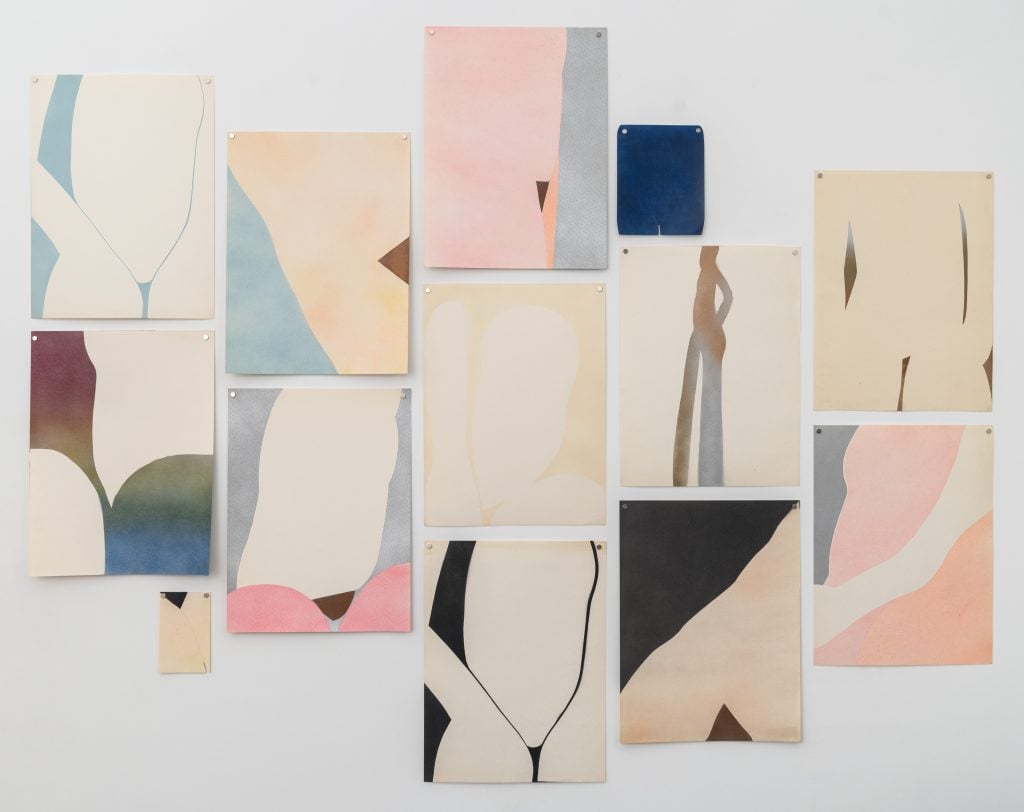
Installation view “Susan Weil” 2024, showing Weil’s spray paint works from 1971. Photograph by Cary Whittier. Courtesy of JDJ Gallery.
Weil is a poet as well as an artist. Since the 1980s she has created a daily practice of “Poemumbles” poems which she shares with her friends and family daily. Often she merges her poems with spontaneous drawings, creating a delightful synthesis of words and form. The exhibition touches on these passions; several art books made by Weil are included in the exhibition. James Joyce comes to the fore as a particular fascination for Weil, as well. The artist’s “Floras” series of spray-painted abstracted women’s bodies alludes to the symbolic language used by the Irish poet and author’s famed novel A Portrait of the Artist as a Young Man.
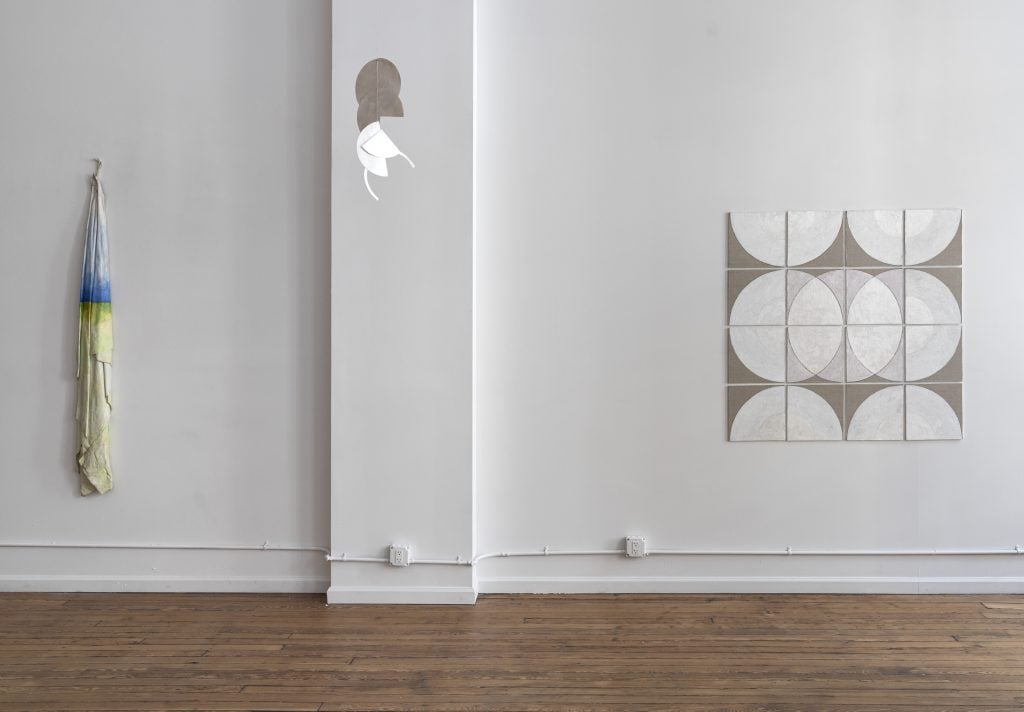
Installation view “Susan Weil” 2024. Photograph by Cary Whittier, Courtesy of JDJ Gallery.
The highlights of the exhibition, however, are Weil’s “Soft Folds” dating from the 1970s through the 90s. These painted canvases, often of skies or horizon lines, have been folded, hung, or draped into sculptural forms. The exhibition includes several of these works including Soft Landscape, from 1972, the earliest work in the series. “To make a big painting and fold it down so that you see it as the heart of the image, I feel that’s very impactful,” said Weil of Soft Landscape. Another, Three Graces, loops a canvas painted a soft pale green into three soft folded pleats, an allusion to classical drapery and depictions of the three daughters of Zeus, while simultaneously alluding to Weil’s own mother, named Grace.
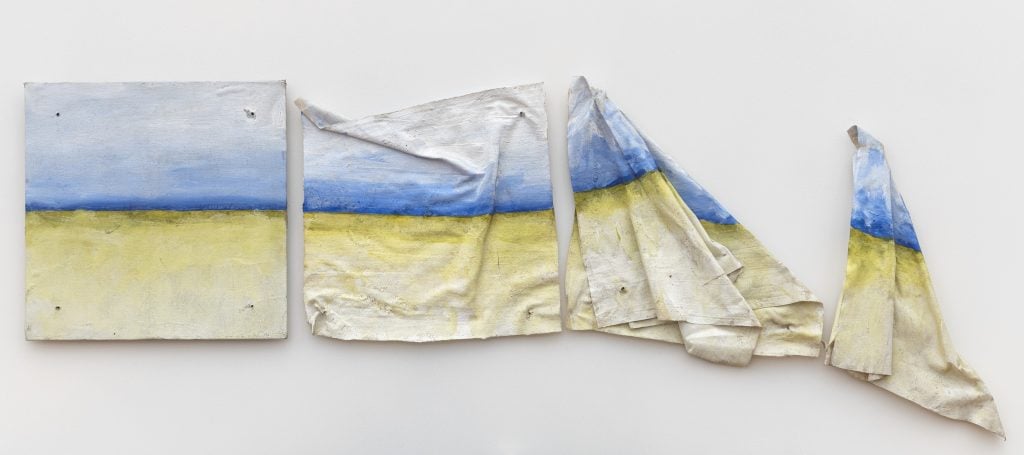
Susan Weil, Untitled (1972). Photograph by Cary Whittier. Courtesy of JDJ Gallery.
Weil’s works thrive at this intersection between the cosmic and the intimate, the eternal and the spontaneous. Across the nearly 60 years of work charted in this exhibition, Weil pulls us into a dance through time that remains joyful, curious, and quick-witted—and it hasn’t stopped yet. Weil is currently hard at work on large-scale triptychs “expressing time’s motion and the bigger picture.”